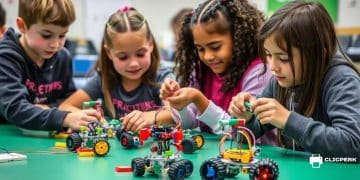Impact of technology on child development: what to know

Anúncios
The impact of technology on child development includes both benefits, like enhanced learning opportunities, and challenges, such as excessive screen time affecting physical and mental health.
Impact of technology on child development raises important questions for parents today. How is technology shaping our kids’ lives? Let’s explore this together and find out!
Anúncios
Understanding child development stages
Understanding the stages of child development is crucial for parents and caregivers. Each stage marks significant changes in a child’s physical, emotional, and cognitive abilities. Recognizing these stages can help adults support children effectively.
Infancy (0-2 years)
In the infancy stage, children begin to develop trust and attachment. They rely heavily on their caregivers for comfort and security. It’s during this time that sensory skills develop, and infants learn about their surroundings primarily through their senses.
Anúncios
Toddlerhood (2-4 years)
This period is characterized by rapid growth and discovery. Toddlers are eager to explore, which sometimes leads to challenging behaviors. Communication skills start to emerge during these years. Parents should encourage positive language development by engaging in conversations and reading aloud.
- Encourage play to enhance motor skills.
- Introduce simple vocabulary through everyday conversations.
- Provide a safe environment for exploration.
The foundation for social skills is also laid as toddlers begin to interact with peers and caregivers. Their emotions can be intense, and understanding these feelings is key.
Preschool (4-5 years)
At this stage, children become more independent and start to develop a sense of identity. They like to ask questions and seek answers about the world around them. Engaging in group activities can greatly benefit their social development.
Early Childhood (5-7 years)
As children reach early childhood, their cognitive skills grow rapidly. They start to understand concepts like rules and consequences. This stage is critical for learning to cooperate and socialize with others. Encouraging participation in group games can enhance these skills.
- Promote teamwork through collaborative projects.
- Introduce basic problem-solving activities.
- Encourage creative expression through art and play.
The impact of technology can also be seen as children may start using educational apps and devices that enhance their learning experience. However, balance is essential. It’s important to ensure that technology use doesn’t replace real-world interactions.
Positive effects of technology on learning
Technology has a profound influence on learning. It provides children with resources and tools that can enhance their educational experiences in amazing ways. Children can access information quickly, which makes learning more engaging and interactive.
Enhanced Access to Information
With the internet, children can explore various topics that interest them. This access enriches their knowledge and motivates them to learn more. Being able to research freely can spark curiosity and drive.
Interactive Learning Tools
Educational apps and software often incorporate games that make learning fun. These tools can teach coding, math, and language skills through engaging activities. When learning feels like play, children are more likely to participate.
- Interactive quizzes to reinforce knowledge.
- Games that enhance critical thinking and creativity.
- Visual aids, like videos and simulations, that clarify complex concepts.
When used thoughtfully, technology can also support different learning styles. Visual learners may benefit from videos, while auditory learners can listen to lectures or podcasts. This flexibility accommodates various needs in a classroom setting.
Collaboration and Communication
Technology encourages collaboration among students. Online platforms allow kids to work together, share ideas, and provide feedback on each others’ work. This teamwork fosters important social skills.
Alongside collaboration, technology breaks geographical barriers. Kids can connect with peers from different backgrounds, enriching their understanding of the world. Engaging in cultural exchanges can teach empathy and awareness.
The positive effects of technology on learning are numerous. As children learn to navigate digital tools, they are also developing essential skills for future challenges. However, it remains critical to balance technology with traditional approaches to learning.
Challenges posed by excessive screen time

Excessive screen time presents several challenges for children today. As technology becomes a bigger part of their lives, understanding the effects is important for parents and caregivers. Too much time spent in front of screens can hinder a child’s development.
Impact on Physical Health
One significant issue is the impact on physical health. Spending long hours in front of screens can lead to sedentary behavior. This can increase the risk of obesity among children. Parents should encourage regular breaks during screen use and promote physical activities.
Effects on Sleep
Another challenge is sleep disruption. The blue light emitted by screens can interfere with the body’s ability to fall asleep. Many children find it hard to settle down after using screens, which can lead to sleep deprivation. Establishing screen-free times, especially before bed, is crucial.
- Promote a calming bedtime routine.
- Keep screens out of bedrooms.
- Set limits on screen use in the evening.
In addition to physical and sleep issues, excessive screen time can hinder social development. Children may miss out on face-to-face interactions that are essential for developing social skills. They might find it difficult to communicate effectively with peers.
Emotional and Mental Health Effects
Moreover, spending too much time on screens can impact emotional well-being. Children who are constantly absorbed in technology may feel more isolated. This can lead to feelings of anxiety and depression.
Younger children, in particular, might struggle to distinguish between real-life interactions and virtual ones. Teaching them about the importance of in-person communication can help them develop better relationships.
When discussing the challenges posed by excessive screen time, it’s essential for parents to monitor and guide their children’s technology use. By setting reasonable boundaries, families can ensure that technology remains a positive influence in their lives.
Balancing technology with outdoor activities
Balancing technology with outdoor activities is essential for children’s overall development. As kids increasingly enjoy screen time, finding ways to encourage outdoor play becomes crucial. Engaging in nature and physical activity can complement what they learn through technology.
Benefits of Outdoor Activities
Outdoor activities promote physical health. Playing outside allows children to develop their motor skills and coordination. It also encourages an active lifestyle, which can prevent obesity and other health issues. Fresh air and sunshine contribute to their overall well-being.
Connecting with Nature
Spending time outdoors helps children connect with nature. Exploring parks, hiking trails, and gardens can spark curiosity about the environment. They learn about ecosystems and wildlife, enhancing their appreciation for the world around them.
- Nature walks can boost awareness of different species.
- Gardening can teach responsibility and care for living things.
- Outdoor games foster teamwork and social skills.
While technology offers numerous educational opportunities, it’s crucial for children to experience the world firsthand. Engaging in physical play supports social interaction, as they can build friendships through shared activities.
Creating a Balanced Schedule
To achieve a healthy balance, parents can create a schedule that includes both technology use and outdoor time. Setting limits on screen time encourages children to explore other interests, like sports, gardening, or just playing outside with friends. Establishing specific “no-screen” times, especially during family meals or after school, can promote engagement in outdoor activities.
Incorporating outdoor activities into daily routines is beneficial for kids. It nurtures a well-rounded lifestyle that emphasizes physical health and emotional well-being. When children learn to appreciate nature, they also develop a sense of respect for their environment, fostering responsible future citizens.
Tips for parents on managing tech use
Managing technology use among children can be challenging but is important for their well-being. Here are some effective tips for parents to help guide their children in using technology wisely.
Establish Clear Rules
Setting clear rules about technology use can help children understand expectations. Parents should create limits on the amount of time spent on screens each day. It’s also useful to outline what types of content are appropriate.
Encourage Open Communication
Having regular conversations about technology is vital. Parents can ask their children about their online experiences, encouraging them to share what they enjoy and any challenges they face. This helps build trust and allows parents to address concerns.
- Discuss the importance of privacy and security online.
- Talk about the potential risks of interacting with strangers on the internet.
- Encourage them to ask questions if they encounter something troubling.
Involving children in discussions about technology can help them make better choices. They learn to think critically about their screen time and the content they consume.
Create Tech-Free Zones
Establishing tech-free zones in the home, such as during family meals or in bedrooms, encourages children to engage in other activities. This time can be spent on family bonding, reading, or outdoor play, which are all valuable experiences.
Moreover, parents should lead by example. Demonstrating healthy technology habits encourages children to mirror those behaviors. If parents are mindful of their own screen time, children are likely to follow suit.
Another important aspect is to choose educational activities over purely entertainment-focused ones. Introducing children to interactive learning apps or educational games can make technology use more beneficial. Balance is the key in creating a healthy approach to technology.





